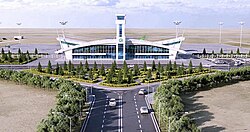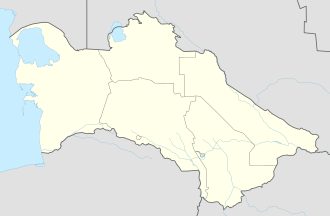Etymology
According to Atanyyazow, the name Kerki is most likely of Persian origin, from ker ("fortress") and kuh ("mountain"), meaning "fortress on a mountain". [4] However, Muqaddasī and de Goeje assert it is a Turkified pronunciation of the Persian name Karkuh (کرکوه), meaning "deaf mountain". [5] The ancient name, Zamm, is of obscure origin.
On 29 December 1999, by Parliamentary Resolution HM-60, the city and district of Kerki were renamed Atamyrat in honor of Atamyrat Nyýazow, father of Saparmurat Niyazov, who had worked in Kerki as a teacher before being killed in World War II. On 25 November 2017, by Parliamentary Resolution No. 679-V, Atamyrat was changed back to Kerki for both the city and the district. [6]
Transportation
Air
The town is served by the new Kerki Airport, which replaced a defunct municipal airport in 2021. [8]
Road
Kerki lies on the P-36 and P-39 highways, which both lead northwest to Turkmenabat, one on each side of the Amu Darya. Nearby junctions connect to the P-89, which leads north to the border with Uzbekistan at Tallymerjen, and the P-37, which leads southeast to the border with Uzbekistan at Kelif. In the opposite direction the P-36 also continues south to a junction with the Kerki-Ymamnazar ýoly, which in turn leads to the border with Afghanistan at Ymamnazar. [9] In February 2013, a road bridge connecting the city with Kerkichi was commissioned; [10] it replaced an old pontoon bridge. [7]
Rail
In 1999, the rail line from Türkmenabat to Kerki was finished, linking Kerki to the Turkmen railway network without having to detour into neighbouring Uzbekistan. [11] In late 2016, a railway line was built south to Ymamnazar on the border with Afghanistan and further to Aqina, turning Kerki into a railway hub. [12]
This page is based on this
Wikipedia article Text is available under the
CC BY-SA 4.0 license; additional terms may apply.
Images, videos and audio are available under their respective licenses.

